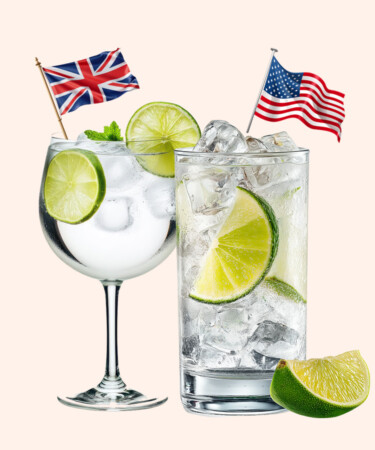The Gin & Tonic is easily one of the world’s most famous cocktails, enjoyed far and wide for its simple preparation and refreshing, botanical flavors. Practically ubiquitous across Europe and the United Kingdom, the G&T might be slightly less popular in the United States, though no less beloved. And while some U.S.-based bartenders have been trying to make elevated versions of the Gin & Tonic happen, the drink is mostly relegated to dive bars and night-out orders stateside.
If you order a G&T anywhere in the U.S., nine times out of 10 it will be served in a highball glass garnished with a lemon or lime wedge. Head across the Atlantic, though, and it’s likely to be a different story.
The cocktail itself first emerged in the mid-1800s. At the time, the British government controlled India, and the risk for malaria was quite high. Tonic water, which historically contained higher concentrations of quinine, was consumed by British soldiers to treat the disease. But given tonic’s bitterness, soldiers tended to mix it with gin and citrus, thus creating the G&T as we know it today.
But while the cocktail may have roots in the United Kingdom and its territories (where it remains beloved to this day), it’s actually the Spanish who modified the serve that’s now most popular throughout Europe. And it all starts with the glassware.
If you order a G&T in Spain — or a Gin Tonic or Gin Tónica, as it’s referred to there — your drink will almost certainly arrive in a bulbous wine glass called a copa de balón. These glasses tend to have roughly double the volume as a standard highball glass, and can accommodate more ice, more tonic water, and more garnishes. In short, the copa de balón simply brings more to the Gin & Tonic.
Beyond offering more space for the liberal use of ingredients, the copa de balón actually has some seriously practical benefits beyond what’s offered by the highball. As the bulb actually holding the drink sits atop a stem, it prevents the drinker’s hand from warming the glass. Moreover, the wider bowl allows for aromas and flavors to develop more than they can in a highball, with botanicals swimming around in the bowl before the narrow opening pushes them to the nose.
This style of Gin & Tonic is thought to have emerged in the early 2000s in the Basque region of Spain. At the time, San Sebastián held a series of gastronomy summits and each night, the chefs attending the conferences would drink Gin & Tonics from big, balloon-shaped glasses filled with ice and garnishes. Instead of simply a slice of citrus, Spanish G&Ts tend to be decorated with herbs like thyme or rosemary, citrus wedges, juniper berries, edible flowers, and more.
But while the copa de balón might be best for aromatics and garnishes, that doesn’t mean the highball is all bad. In fact, the tall, narrow glass has a few pros of its own when it comes to Gin & Tonic service, namely that the elongated, slender shape prevents the tonic water from going flat. It also has a different aesthetic benefit — while the copa de balón shows off the vast array of garnishes, the highball showcases the tonic water’s vivacious bubbles. It’s also arguably easier to hold and drink from if you’re at a packed bar.
While the majority of American bars and restaurants serve G&Ts in highballs, getting one in a copa isn’t unheard of on American soil. At most Spanish and tapas restaurants in the States, G&Ts arrive just like they do in Spain — in a copa de balón brimming with garnishes.
